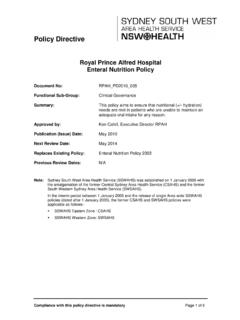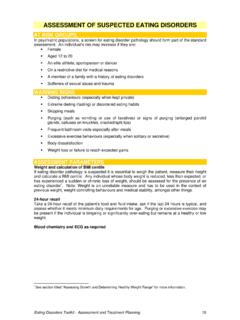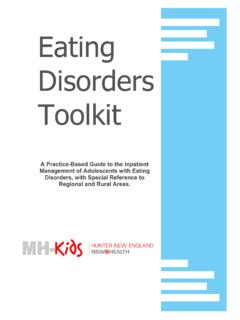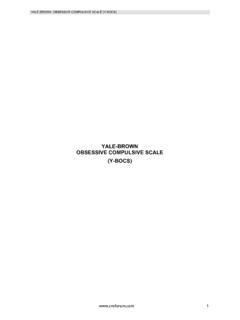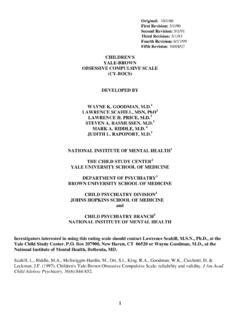Transcription of K-SADS-PL version 1
1 K-SADS-PL , version , October 1996 1996, Kaufman, Birmaher, Brent, Rao All rights reservedDiagnostic InterviewKiddie-Sads-Present and Lifetime version ( K-SADS-PL ) version of October 1996 Permitted UsageThis instrument is copyrighted. Usage is freely permitted without further permission for uses which meet one or moreof the following:CClinical usage in a not-for-profit institutionCUsage in an IRB approved research protocolAll other uses require written permission of the principal author, Dr. Kaufman, including but not limited to thefollowing:CRedistribution of the instrument in printed, electronic or other formsCCommercial use of the instrumentThe latest version of the instrument, a pointer to the author s electronic mail address, and other useful information canbe found at the following WorldWide Web URL: http:\\ \ksadsK-SADS-PL, version , October 1996 1996, Kaufman, Birmaher, Brent, Rao All rights reservedVersion of 10/01/96 Diagnostic InterviewKiddie-Sads-Present and Lifetime version ( K-SADS-PL ) - Screen Interview -Child's Name.
2 MR # Clinician: ID# Clinic: Psychiatrist: Date of Interview: Month Day YearThe K-SADS-PL was adapted from the K-SADS-P (Present Episode version ), which was developed by WilliamChambers, and Joaquim Puig-Antich, , and later revised by Joaquim Puig-Antich, and Neal Ryan, The K-SADS-PL was written by Joan Kaufman, , Boris Birmaher, , David Brent, , Uma Rao, , and Neal Ryan, The K-SADS-PL was designed to obtain severity ratings of symptomatology, and assesscurrent and lifetime history of psychiatric disorders, including several disorders not surveyed in the K-SADS-P.
3 Thecurrent instrument is greatly indebted to several other existing structured and semi-structured psychiatric instrumentsincluding the K-SADS-E (Orvaschel & Puig-Antich), the SADS-L (Spitzer and Endicott), the SCID (Spitzer, Williams,Gibbon, and First), the DIS (Robins and Helzer), the ISC (Kovacs), the DICA (Reich, Shayka, and Taibleson), and theDUSI (Tarter, Laird, Bukstein, and Kaminer). Guidelines for the introductory interview at the beginning of thisinstrument were provided by Michael Rutter, and Philip Graham, , and modifications for the anxietydisorders section were provided by Cynthia Last, Other consultants include Oscar Bukstein, , Walter Kaye, , David Kolko, , Rolf Loeber, , William Pelham, , David Rosenberg, and John Walkup, Appreciation is extended to all contributors, as well as to Denise Carter-Jackson, for the word processing of thisinstrument.
4 Sections Completed: Screen Interview #1 #2 #3 #4 #5K-SADS-PL, version , October 1996 1996, Kaufman, Birmaher, Brent, Rao All rights reservedTABLE OF CONTENTSPageIntroduction iBackground Information1 Depressive Disorders 7 Mania 12 Psychosis 14 Panic Disorder16 Separation Anxiety Disorder17 Avoidant Disorder/Social Phobia20 Agoraphobia/Specific Phobias24 Overanxious/Generalized Anxiety 25 obsessive compulsive Disorder 27 Enuresis 29 Encopresis 31 Anorexia Nervosa 33 Bulimia Nervosa 34 Attention Deficit Hyperactivity Disorder 36 Oppositional Defiant Disorder 38 Conduct Disorder 40 Tic Disorder42 Cigarette Use 43 Alcohol Abuse 44 Substance Abuse 46 Post-Traumatic Stress Disorder 48 Children's Global Assessment Scale
5 571 Diagnostic Summary Sheets 59 Drug List 61 Supplement Completion Checklist62 Shaffer, D., Gould, M., Brasic, J., Ambrosini, P., Fischer, P., Bird, H., and Aluwahlia, S. A Children's Global1 Assessment Scale (CGAS). Arch Gen Psychiatry, 1983, 40 , version , October 1996 1996, Kaufman, Birmaher, Brent, Rao All rights reservedSchedule for Affective Disorders and Schizophreniafor School Aged Children (6-18 Years)Kiddie-SADS - Lifetime version ( K-SADS-PL )The K-SADS-PL is a semi-structured diagnostic interview designed to assess current and past episodes ofpsychopathology in children and adolescents according to DSM-III-R and DSM-IV criteria.
6 Probes and objectivecriteria are provided to rate individual symptoms. The primary diagnoses assessed with the K-SADS-PL include: MajorDepression, Dysthymia, Mania, Hypomania, Cyclothymia, Bipolar Disorders, Schizoaffective Disorders,Schizophrenia, Schizophreniform Disorder, Brief Reactive Psychosis, Panic Disorder, Agoraphobia, SeparationAnxiety Disorder, Avoidant Disorder of Childhood and Adolescence, Simple Phobia, Social Phobia, OveranxiousDisorder, Generalized Anxiety, obsessive compulsive Disorder, Attention Deficit Hyperactivity Disorder, ConductDisorder, Oppositional Defiant Disorder, Enuresis, Encopresis, Anorexia Nervosa, Bulimia, Transient Tic Disorder,Tourette's Disorder, Chronic Motor or Vocal Tic Disorder, Alcohol Abuse.
7 Substance Abuse, Post-Traumatic StressDisorder, and Adjustment K-SADS-PL is a semi-structured interview. The probes that are included in the instrument do not have tobe recited verbatim. Rather, they are provided to illustrate ways to elicit the information necessary to score each item. The interviewer should feel free to adjust the probes to the developmental level of the child, and use language suppliedby the parent and child when querying about specific K-SADS-PL is administered by interviewing the parent(s), the child, and finally achieving summaryratings which include all sources of information (parent, child, school, chart, and other).
8 When administering theinstrument to pre-adolescents, conduct the parent interview first. In working with adolescents, begin with them. Whenthere are discrepancies between different sources of information, the rater will have to use his/her best clinicaljudgement. In the case of discrepancies between parents' and child's reports, the most frequent disagreements occur inthe items dealing with subjective phenomena where the parent does not know, but the child is very definite about thepresence or absence of certain symptoms. This is particularly true for items like guilt, hopelessness, interrupted sleep,hallucinations, and suicidal ideation.
9 If the disagreements relate to observable behavior ( truancy, fire setting, or acompulsive ritual), the examiner should query the parent(s) and child about the discrepant information. If thedisagreement is not resolved, it is helpful to see the parent(s) and child together to discuss the reasons for thedisagreement. Ultimately the interviewer will have to use his/her best clinical judgment in assigning the summaryratings. iiK-SADS-PL, version , October 1996 1996, Kaufman, Birmaher, Brent, Rao All rights reservedThe following guidelines should be used in coding Diagnoses: In coding current episodes (CE) of disorders, symptoms should be rated for the timeperiod when they were the most severe during the episode.
10 Note in the margins if and when particularsymptoms ( insomnia) improved or Targeted with Medication: In coding disorders treated with medication ( ADHD), use the ratingsto describe the most intense severity of symptoms experienced prior to initiation of medication or during 'drugholidays'. Note in margins symptoms targeted effectively with medication. Diagnoses: In order for an episode to be considered 'resolved' or 'past', the child should have had aminimum of two months free from the symptoms associated with the disorder. Episodes rated in the pastdisorders section should represent the most severe past (MSP) episode experienced of that given disorder.
